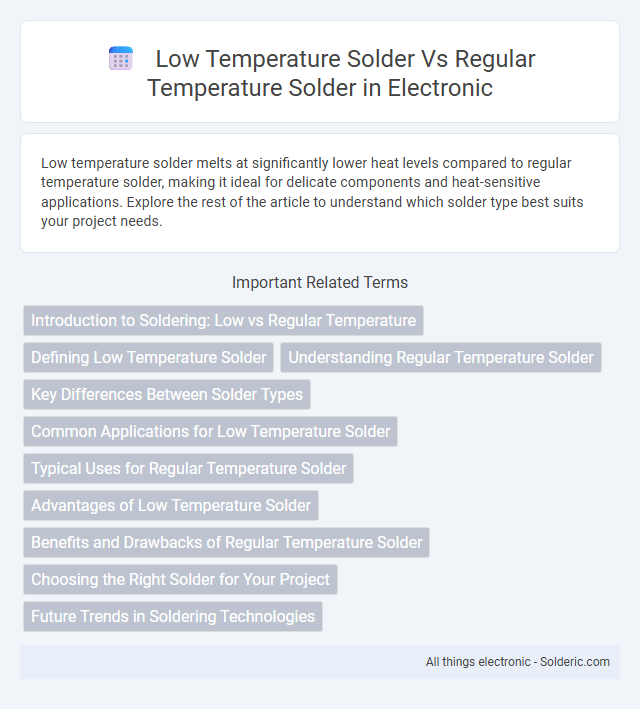Low temperature solder melts at significantly lower heat levels compared to regular temperature solder, making it ideal for delicate components and heat-sensitive applications. Explore the rest of the article to understand which solder type best suits your project needs.
Comparison Table
| Feature | Low Temperature Solder | Regular Temperature Solder |
|---|---|---|
| Melting Point | Below 180degC (typically 138degC - 179degC) | Above 180degC (typically 183degC - 240degC) |
| Common Alloys | BiSn (Bismuth-Tin), SnIn (Tin-Indium), SnPb (Tin-Lead with low temp mix) | SnPb (Tin-Lead), SAC (SnAgCu - Tin-Silver-Copper) |
| Applications | Heat-sensitive components, PCB repair, multi-layer boards | General electronics, high-reliability assemblies |
| Thermal Stress | Low thermal stress, prevents damage to components | Higher thermal stress, risk of damage to sensitive parts |
| Strength & Durability | Generally lower mechanical strength | Higher mechanical strength and durability |
| Environmental Impact | Often lead-free, environmentally friendly | Includes leaded options, environmental concerns |
| Cost | Typically higher due to specialized alloys | Generally more economical and widely available |
Introduction to Soldering: Low vs Regular Temperature
Low temperature solder melts between 138degC to 183degC, making it ideal for delicate components that cannot withstand high heat, while regular temperature solder typically melts around 217degC to 227degC, providing stronger mechanical bonds for durable electronic connections. Using low temperature solder helps prevent thermal damage to sensitive parts, preserving your device's integrity during repairs or assembly. Regular solder offers better conductivity and mechanical strength, suited for applications requiring robust and long-lasting joints.
Defining Low Temperature Solder
Low temperature solder is defined by its melting point, typically ranging between 138degC and 183degC, significantly lower than regular temperature solder, which melts around 217degC to 227degC. This type of solder is ideal for heat-sensitive components and substrates, reducing the risk of thermal damage during assembly. Common alloys for low temperature solder include bismuth-tin (Bi-Sn) and indium-based combinations, offering reliable electrical conductivity and mechanical strength at reduced processing temperatures.
Understanding Regular Temperature Solder
Regular temperature solder typically melts between 183degC and 190degC, commonly using a tin-lead or lead-free alloy composition to ensure strong mechanical and electrical connections. It offers excellent joint reliability and conductivity, making it suitable for most standard electronics manufacturing applications. Understanding the melting point and alloy properties of regular temperature solder helps you choose the right material for durability and efficient assembly in your projects.
Key Differences Between Solder Types
Low temperature solder melts at temperatures typically below 180degC, making it ideal for heat-sensitive components, whereas regular temperature solder usually melts between 217degC and solder melting ranges impact joint integrity and thermal cycling performance. Low temperature solder often contains alloys like bismuth-tin, while regular temperature solder commonly uses tin-lead or lead-free compositions such as SAC305, influencing solderability and mechanical strength. Differences in melting point, alloy composition, and thermal stress tolerance define the key distinctions between low and regular temperature solders.
Common Applications for Low Temperature Solder
Low temperature solder is commonly used in electronics repair, especially for sensitive components that could be damaged by heat, such as in smartphones, laptops, and delicate circuit boards. It is ideal for rework and prototyping where preserving component integrity and minimizing thermal stress is critical. Your projects involving temperature-sensitive elements benefit from the reduced melting point and reliable bonding of low temperature solder compared to regular temperature solder.
Typical Uses for Regular Temperature Solder
Regular temperature solder, commonly made from a tin-lead alloy with a melting point around 183degC (361degF), is widely used in electronics manufacturing and repair due to its reliable electrical conductivity and mechanical strength. It effectively bonds components on printed circuit boards (PCBs) and is preferred for applications that require durable and permanent connections under standard operating conditions. Your projects involving standard electronic assemblies benefit from regular temperature solder's proven performance and ease of use.
Advantages of Low Temperature Solder
Low temperature solder offers several advantages, including reduced risk of thermal damage to sensitive components and circuit boards due to its lower melting point, typically below 180degC. It allows for quicker heating and cooling cycles, which can improve manufacturing efficiency and decrease energy consumption. Your electronic assemblies benefit from enhanced reliability and less stress on components, making it ideal for repair work and delicate applications.
Benefits and Drawbacks of Regular Temperature Solder
Regular temperature solder typically melts between 183degC and 250degC, providing strong mechanical bonds ideal for high-temperature applications. Its benefits include superior joint reliability, excellent electrical conductivity, and durability under thermal stress, making it suitable for heavy-duty electronics and industrial uses. Drawbacks involve the risk of heat damage to sensitive components and circuit boards due to higher melting points, potentially causing warping or delamination.
Choosing the Right Solder for Your Project
Low temperature solder melts between 138degC to 183degC, making it ideal for sensitive components prone to heat damage, like LEDs and semiconductors, while regular temperature solder typically melts between 217degC to 221degC, providing stronger, more durable joints for general electronics and metalwork. Choosing the right solder depends on the thermal tolerance of the components, project requirements, and the desired strength of the solder joint. Low temperature solder ensures protection of fragile parts, whereas regular solder offers improved mechanical integrity and conductivity for robust applications.
Future Trends in Soldering Technologies
Low temperature solder offers significant advantages in minimizing thermal stress and protecting heat-sensitive components compared to regular temperature solder, which typically requires higher melting points. Emerging trends in soldering technologies emphasize eco-friendly materials and precise temperature control, enhancing reliability and energy efficiency in electronic manufacturing. Your choice between low and regular temperature solder will increasingly depend on the integration of smart soldering systems that optimize performance and sustainability.
low temperature solder vs regular temperature solder Infographic

 solderic.com
solderic.com